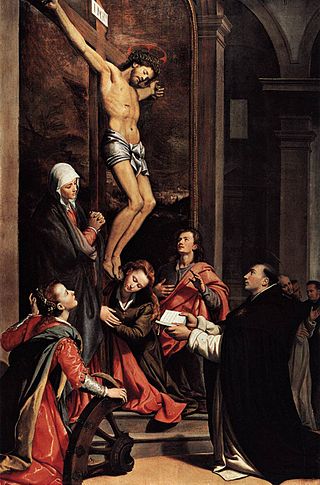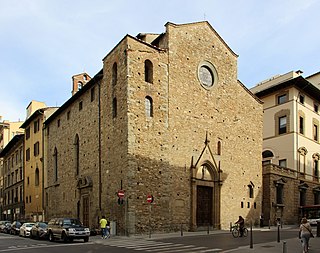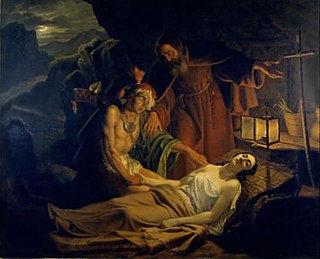Related Research Articles

Florence is a city in Central Italy and the capital city of the Tuscany region. It is the most populated city in Tuscany, with 383,083 inhabitants in 2016, and over 1,520,000 in its metropolitan area.

Paolo Uccello, born Paolo di Dono, was an Italian painter and mathematician who was notable for his pioneering work on visual perspective in art. In his book Lives of the Most Excellent Painters, Sculptors, and Architects, Giorgio Vasari wrote that Uccello was obsessed by his interest in perspective and would stay up all night in his study trying to grasp the exact vanishing point. While his contemporaries used perspective to narrate different or succeeding stories, Uccello used perspective to create a feeling of depth in his paintings. His best known works are the three paintings representing the battle of San Romano, which were wrongly entitled the Battle of Sant'Egidio of 1416 for a long period of time.

Domenico di Tommaso Curradi di Doffo Bigordi, professionally known as Domenico Ghirlandaio, also spelled as Ghirlandajo, was an Italian Renaissance painter born in Florence. Ghirlandaio was part of the so-called "third generation" of the Florentine Renaissance, along with Verrocchio, the Pollaiolo brothers and Sandro Botticelli. Ghirlandaio led a large and efficient workshop that included his brothers Davide Ghirlandaio and Benedetto Ghirlandaio, his brother-in-law Bastiano Mainardi from San Gimignano, and later his son Ridolfo Ghirlandaio. Many apprentices passed through Ghirlandaio's workshop, including the famous Michelangelo. His particular talent lay in his ability to posit depictions of contemporary life and portraits of contemporary people within the context of religious narratives, bringing him great popularity and many large commissions.

Santi di Tito was one of the most influential and leading Italian painters of the proto-Baroque style – what is sometimes referred to as "Counter-Maniera" or Counter-Mannerism.

Firenze Santa Maria Novella or Stazione di Santa Maria Novella is the main railway station in Florence, Italy. The station is used by 59 million people every year and is one of the busiest in Italy.

Raffaellino del Garbo (1466–1527) was a Florentine painter of the early Renaissance.

Ventura di Archangelo Salimbeni was an Italian Counter-Maniera painter and printmaker highly influenced by the vaghezza and sensual reform of Federico Barocci.

Santa Maria Maggiore di Firenze is a Romanesque and Gothic-style, Roman Catholic church in Florence, region of Tuscany, Italy. This is among the oldest extant churches in Florence.

Andrea della Robbia was an Italian Renaissance sculptor, especially in ceramics.

Florentine painting or the Florentine School refers to artists in, from, or influenced by the naturalistic style developed in Florence in the 14th century, largely through the efforts of Giotto di Bondone, and in the 15th century the leading school of Western painting. Some of the best known painters of the earlier Florentine School are Fra Angelico, Botticelli, Filippo Lippi, the Ghirlandaio family, Masolino, and Masaccio.

Giovanni Maria Morandi was an Italian painter, mainly active in Rome and his natal city of Florence, but also Venice. He is said to have briefly trained in Florence with Sigismondo Coccapani and Giovanni Bilivert.

Giuseppe Bezzuoli was an Italian painter of the Neoclassic period, active in Milan, Rome, and his native city of Florence.

Giovanni Michelucci, Italian architect, urban planner and designer, was born in Pistoia, Tuscany, on 2 January 1891 and died on the night of 31 December 1990, two days before his 100th birthday, at his studio-home in Fiesole, in Florence's hills, now the headquarters of his Foundation. He had the good fortune to live a long life almost entirely within the span of the twentieth century, giving us a valuable witness through his work with innovative architectural vernaculars and proposals, from his understanding of the complexity of events, transformations, and ideas that animated the twentieth century. He was one of the major Italian architects of that century, known for famous projects such as the Firenze Santa Maria Novella railway station and the San Giovanni Battista church on the Autostrada del Sole.

Luigi Bellincioni was an Italian architect and engineer.
Domenico Pesenti was an Italian painter and antiquarian. He painted mainly vedute.

Luigi Serra was an Italian painter, known for his watercolors.

Alberto Pisa was an Italian painter, often painting ruins, landscapes, and garden views in bright watercolor.

Cesare Mussini was a German-Italian painter. He spent many years of his life as a painter in Russia.
Gioacchino Gamberini was an Italian painter noted for genre painting as well as city and rural views.
References
- ↑ Istituto Matteuci biography.
- ↑ Dizionario degli Artisti Italiani Viventi: pittori, scultori, e Architetti., by Angelo de Gubernatis. Tipe dei Successori Le Monnier, 1889, page 363.